Warning
This tech note is an obsolete design document for authentication to the Rubin Science Platform (prior to it receiving that name). The design presented here has been heavily revised and is no longer current. It is preserved solely for historical reference.
This is part of a tech note series on identity management for the Rubin Science Platform. The primary documents are DMTN-234, which describes the high-level design; DMTN-224, which describes the implementation; and SQR-069, which provides a history and analysis of the decisions underlying the design and implementation. See the references section of DMTN-224 for a complete list of related documents.
1 Introduction¶
This document covers core technologies and interactions between services, APIs, and applications interacting with the LSST Science Platform. The authentication use cases covered in this cover interactive users who are primarily interacting with the LSP in the following ways:
Logged into the notebook aspect
Logged into the portal aspect
From a local terminal, exercising the API aspect from third party libraries or applications
For the users in question, we make a few assumptions about use of the LSP in this context:
Users include LSST staff and scientists that are members of science collaborations.
Users already have an NCSA/LSST account through some mechanism. If they wish to use federated credentials, the assumption is that their federated credentials have been associated with their NCSA account.
Users are active, continuously or intermittently, over the course of an extended work day. Interactions will typically last several hours, though the system should be prepared for interactions lasting up to 24 hours.
At the start of an interaction with the LSP system, users do not know which types of data they will access. Users do know which services they will access.
2 Basic Concepts¶
We define users and groups within this document, as well as minimal requirements from the IAM system as needed by the LSP, and likely the broader Data Management System.
Note
Further definition of the IAM system will be available in the future in a change controlled document.
2.1 User¶
A user is minimally identified by either a UNIX ID number (UID) or a user name. A service MUST be able to lookup a UID if it has a user name, or a user name if it has a UID.
2.1.1 Real Accounts¶
A user account identifying a specific person is a real account. All LSST users in the US and Chilean DACs have an LSST account. An LSST account is also the same account as an NCSA UNIX (Kerberos) account.
2.2 Groups¶
A user is a member of one or more groups. All groups defined for a given user are owned exclusively by that user. All groups a user creates MUST follow the group naming conventions outlined by the LSST Chief Security Officer. A core set of groups do not belong to a specific user. These are defined and managed by the LSST system administrators.
The IAM system SHOULD disallow group names that are not representable as UNIX group names or database role names within the Data Management System. This implies a 32 character limit, as limited by Red Hat Linux.
Note
Before Oracle 12.2, there’s a limit of 30 characters on role names.
All users MUST be a member and the only member of a user-private group. The group name should be the name of the user. This follows the Red Hat feature called User Private Groups.
Some systems, to which Groups may be synced to, may not allow assignment of permissions directly to users, only groups. If this is the case, then a user can assign permissions to the user private group. This would enable another user to extend access to a resource by assigning a read permission to the user’s group, for example.
Group membership MUST be discoverable through at least an LDAP service provided by the IAM system. Additional services for querying group membership MAY be implemented.
2.2.1 User and Groups Synchronization¶
When necessary, the IAM system SHOULD create users and groups in underlying systems, synchronizing membership accordingly. The synchronization SHOULD finish in under an hour and MUST finish within 24 hours.
In databases, groups should be represented as roles.
The assignment of privileges on resources according to users and groups is out of scope for this document.
2.2.2 Caching Group Information¶
Clients querying a group membership service SHOULD cache results. Results SHOULD be cached with a TTL for no less than 30 seconds and no longer than 1 hour. A 5 minute TTL is recommended.
Users and services should be made aware of the caching TTL as well as potential latencies due to user and groups synchronization. It may take up to 2 hours for groups to be synchronized and caches invalidated.
If group information is encoded in a token, users MUST be informed to destroy the token through some form of logout mechanism. Single Logout is out of scope for this document.
2.2.3 Privacy and File Sharing¶
Note
This section is informational
Through the use of sticky bits, umasks, and user-private groups, it will be possible to build a system that can both preserve privacy, by setting sticky bits on user-private directories for the user’s user-private group, as well as preserve access on directories that are intended to be shared, such as those owned by a Science Collaboration.
2.3 Roles¶
Note
This section is informational
There’s currently no concept of roles in the existing IAM system for NCSA. A system that represents roles must also have permissions associated with roles. As such, Roles are generally out of scope for this document, but they are mentioned for informational purposes.
Roles often are implemented as group membership. For example, the portal web
application may rely on having the groups lsst_int_portal_usdac_user,
lsst_int_portal_pdac_user, and lsst_int_portal_admin defined. In this example, these groups
are effectively roles. The portal application can limit what a user can do based on membership
in these groups. The portal may also manage the roles in a user session context: a user may be
allowed to be an admin by being a member of the admin group, but the user may assume the user role
by default, with forced re-authentication being necessary to assume the admin role.
2.4 Authentication¶
Authentication in LSST is the act of associating a user with their LSST account.
Authentication by a real user is handled by the IAM system. All authentication for LSP services is handled through the OAuth 2.0 Protocol by the IAM system. Normally this will be through the OpenID Connect layer.
Note
Authentication for a shared account is out of scope for this document. It’s assumed that users may be members of groups that are owned by shared accounts, but they will always authenticate as themselves. These details are subject to change.
Note
Authentication using means such as Kerberos is out of scope of this document.
2.4.1 identity.lsst.org - Account Management¶
All accounts can be managed through identity.lsst.org. This will
include profile information about the user as well as group management. Users may need to interact
with an LSST administrator in order to be granted the ability to create groups. This can be done by
emailing lsst-account _at_ ncsa.illinois.edu (and CC lsst-sysadmins _at_ lsst.org).
2.4.2 Federated Identity and LSST Accounts¶
In order to improve security and convenience for users, users may associate eligible accounts with their LSST account, enabling them to delegate to third-party authenticators. This association is called Federated Identity, which allows the user to authenticate to LSST services using the associated accounts. CILogon is used to determine eligible authenticators for federated identity; the list typically includes accounts from the InCommon federation, as well as OAuth accounts from services such as Google and GitHub. Association of accounts from third party authenticators to the user’s LSST account is configured through the identity.lsst.org account management portal. Once an account is associated, a user can login using credentials and authentication services from their associated accounts.
After a successful federated authentication from the associated account, the CILogon service MUST produce the equivalent authentication information to that of a successful authentication of an LSST account via the NCSA identity provider.
2.6 Data and Service Classifications¶
Note
This section is informational
Warning
This section is subject to change
These classifications are loosely based on LPM-122 classifications, LDM-542, and LSE-163. Work is being performed to clarify the classifications of data and services together.
Resources |
Operations Allowable |
Risk Level |
Services |
|---|---|---|---|
Image Access |
read |
medium |
Imgserv/SODA (Butler via POSIX), POSIX |
Image Access (Metadata) |
read |
low |
SIA, TAP |
Table Access (DR, Alerts) |
read |
medium |
TAP, QServ (Only through TAP) |
Table Access (Transformed EFD) |
read |
low |
TAP, Consolidated (Notebook via SQL Client) |
Table Access (User and Shared) |
read, write |
high |
TAP, Consolidated (Notebook via SQL Client) |
User Query History |
read |
high |
TAP |
File/Workspace Access |
read |
medium |
WebDAV, VOSpace, POSIX, Notebook (via POSIX) |
File/Workspace Access (User/Shared) |
read, write |
high |
WebDAV, VOSpace, POSIX, Notebook (via POSIX) |
Portal |
execute |
high |
Portal |
Notebook |
execute |
high |
Notebook |
From these data classifications, a set of capabilities has been defined. These capabilities are expressly checked for authorization to the respective services. When a user first logs in, we map a list of all possible capabilities a user may have by checking group membership for a given instance. We do this by constructing LDAP groups and adding users to that group. A group that is defined for this explicit purpose is called a capability group. Membership in a capability group determines the possible capabilities a user may have. For LSST deployments, we use NCSA identity management to control these groups, so we name them using NCSA namespace rules, which assign predefined prefixes. The suffix used for the LSST deployments is given here. Other deployments can name these groups however they wish and can assign multiple capabilities to the same group.
Resources |
Capabilities |
API Access |
Capability Group Suffix |
|---|---|---|---|
Image Access |
read:image |
Yes |
img |
Image Access (Metadata) |
read:image/md |
Yes |
img_md |
Table Access (DR, Alerts) |
read:tap |
Yes |
tap |
Table Access (Transformed EFD) |
read:tap/efd |
Yes |
tap_efd |
Table Access (User and Shared) |
read:tap/user, write:tap/user |
Yes |
tap_usr |
User Query History |
read:tap/history |
Yes |
tap_hist |
File/Workspace Access |
read:workspace |
Yes |
ws |
File/Workspace Access (User/Shared) |
read:workspace/user, write:workspace/user |
Yes |
ws_usr |
Portal |
exec:portal |
No |
portal |
Notebook |
exec:notebook |
No |
nb |
3 Tokens¶
Broadly speaking, there are two main types of tokens in the LSST DM system. Tokens whose primary use is for identity, which are similar to those issued from CILogon, and tokens whose primary use is for checking capabilities. Identity tokens are roughly equivalent to X.509 certificates; they include information about the user identity, including the username for the LSST account and/or and group memberships, in addition to a cryptographic signature for verifying the token integrity using public key encryption. Because of these similarities, they can be used in nearly all use cases covered by X.509 certificates. But identity tokens also allow encoding of much more authentication information about a subject, which is useful in the LSST system. More information can be found about the differences between tokens and certificates in the Tokens vs. X .509 section.
Capability tokens, as expanded in the LSST DM system, will minimally also include the UNIX UID and/or
username for the LSST account, as well as a list of capabilities for the token. Those
capabilities are listed in the scope claim of the token.
3.2 Identity tokens - OpenID Connect¶
All identity tokens are in the form of OpenID Connect tokens. All OpenID connect tokens are JWT tokens. They are issued from CILogon in the exchange. In Approach 1, we only use claims from tokens issued by CILogon. Tokens may be reissued by the token issuer to satisfy the token acceptance guarantee, but all claims are equal to the CILogon claims.
3.2.1 Identity Token Claims¶
Minimally, the identity tokens issued by CILogon MUST include the following claims.
uidNumber:The LSST UNIX UID.
isMemberOf:A list of JSON Objects with the objects composed of a
namekey corresponding to UNIX group names andidkey corresponding to the UNIX GID for the group name.
3.3 Capability tokens - SciTokens¶
All capability tokens are based on SciTokens.
3.3.1 Claims¶
Minimally, the capability token issued by the token issuer MUST include the following claims:
uidNumber:The LSST UNIX UID.
scope:scopeis the scope claim. In our implementation, this is a list of space-separated capabilities. Capabilities are derived from the data and service classifications. This is similar to how GitHub allows scopes.
3.4 Tokens vs. X.509¶
Fundamentally, identity tokens are roughly equivalent to X.509 certificates, though there are several advantages.
X.509 certificates are handled in Layer 4 in the OSI model, which typically leads to a more complicated setup of servers, clients, and applications.
OAuth tokens are handled in Layer 7 of the OSI model, which adds flexibility to configuration.
OAuth JWT tokens can include additional claims that are useful for application developers. OAuth Identity tokens can include arbitrary pieces of data, such as the UNIX UID, UNIX GIDs of the group membership, and additional data about an external identities used during login. They can be short lived, limited in scope, and thanks to OpenID Connect and the JWK spec, they do not require complex certificate handling.
Capabilities-based tokens allow issuance of tokens scoped accordingly to the services that a given application may require. A user may select only the capabilities needed for a given use case, limiting access to sensitive information, such as query history. This is most important in lower trust environments, such as grid computing or shared university clusters.
4 Components¶
4.1 Clients¶
4.1.1 Portal¶
When a user first logs into the portal, the token proxy will intercept the login and redirect them to CILogon. They may select either NCSA as their Identity Provider or an associated external federated identity. CILogon executes the login, ultimately returning information about who the user is at NCSA to the token proxy through CILogon’s OpenID Connect interface as well as an identity token with the proper identity token claims. The token proxy, through the token issuer component, will then reissue the token with the same claims but with a 24-hour lifetime.
The portal will be passed that token in an HTTP request header. It can use the information in the
token to customize its behavior. It passes that token in requests to the API aspect as an
OAuth 2.0 Bearer token via the HTTP Authorization header, according to the OAuth 2.0
Specification:
Authorization: Bearer [TOKEN]
See also
4.1.2 Notebook¶
The portal and the notebook will share the same login flow, both being behind the token proxy. Once the login has progressed past the token proxy and to the notebook, the notebook will initiate a notebook session based on the token that it has received. The notebook can then make the token available in the user’s notebook environment.
A user logged in to the notebook aspect can be viewed as a special case of data access libraries, where we can inject tokens into the user’s local environment. For software developed by LSST that utilizes the LSP API aspect services, we will ensure those applications can be automatically configured based on those tokens. Other third party software may be able to be similarly automatically configured; otherwise they will be configurable in the same way as if a user was running on their local machine and not in an LSP instance.
4.1.3 TOPCAT¶
LSST will be working with the TOPCAT developers to find the best method of authentication. It’s expected that the embedded HTTP basic method will work to start, based on the HTTP Basic scheme for OAuth. Once Approach 2 is fully implemented, it may be desirable to switch to the PKCE flow with refresh tokens.
4.1.4 Data access libraries¶
We are targeting Astroquery and PyVO as primary libraries to be used within the Notebook environment. PyVO doesn’t currently implement any form of authentication, though we’ve prototyped and tested a few strategies for adding it.
Within the Notebook aspect, tokens MUST be available, either in a well-defined environment variable or as a file in a well-defined location.
4.2 Token Manager¶
In both approaches, it’s desirable for clients to auto-configure, if possible, based on the tokens they have available in their environment. Tokens may be issued manually through a token download interface, or they may be issued as part of an OAuth2 PKCE flow when Approach 2 is fully implemented.
4.3 Token Issuer¶
The token issuer component is fundamentally a part of the IAM system. The token issuer’s primary purpose is to issue tokens with appropriate capabilities, based on a combination of information from LDAP and user-selected scopes.
The token issuer component is theoretically not needed for Approach 1, but due to complexities in implementation and integration with the notebook environment, it’s desired for simplification.
The token issuer will handle several use cases:
Token reissuance of identity tokens from Approach 1.
Token reissuance to satisfy the token acceptance guarantee
Token issuance, by way of the token download interface, of capability tokens from Approach 2.
Token issuance, by way of PKCE flow, of refresh tokens and capability tokens from Approach 2. With the PKCE flow, the refresh token can be presented at any time to the token issuer to issue a short-lived capability token.
The token issuer implements a token download interface. Minimally, the token download interface allows a user to select the capabilities a token should be configured with and to download the token.
4.5 Token Proxy¶
The Token Proxy is a single gateway to which can handle OAuth2 authentication flows, and integrate with the token authorization and token issuer components. Critically, through the token issuer, the token proxy implements transparent token reissuance for downstream services.
The reissued token MAY alter the values of the following iss, exp, and iat claims. All
other claims MUST be included in the reissued token, unmodified. Additional claims may also be
included.
When reissuing tokens, the token proxy MUST make those tokens available to the downstream services via HTTP headers:
X-Auth-Request-Token: [token]Authorization: Bearer [token]
Additional information about the user may also be relayed to the services from the token proxy, such as the preferred identity email, LSST username, and LSST UNIX UID:
X-Auth-Request-Email: [email]X-Auth-Request-User: [username]X-Auth-Request-Uid: [uid]
Note
Downstream services may need to rely on some form of header renaming if the service is unable to accept the default headers. This is usually accomplished via reverse proxy configuration.
5 Sequence Diagrams¶
5.1 Approach 1 - Identity Tokens¶
5.1.1 Notebook with Identity Tokens¶
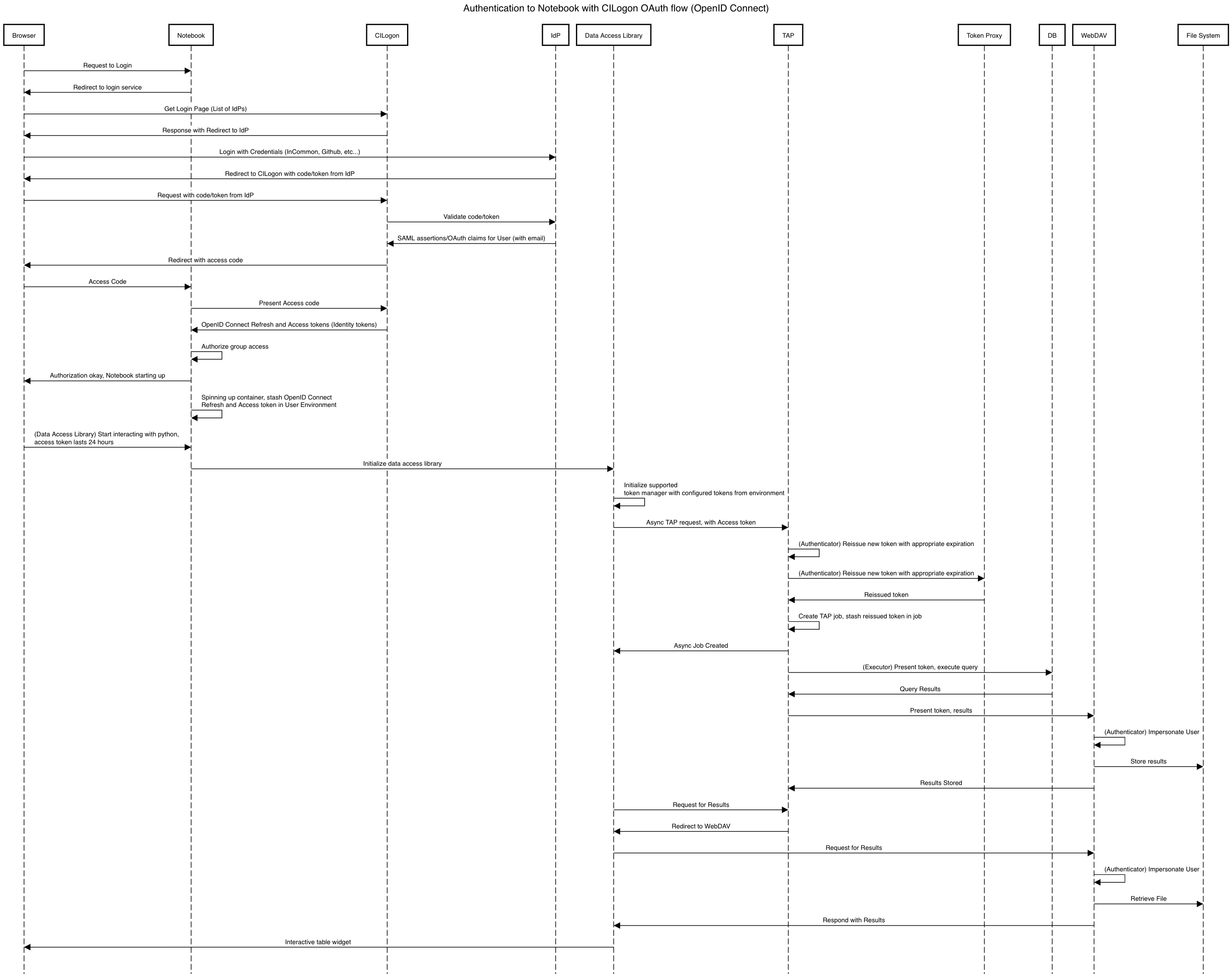
5.1.2 Portal with Identity Tokens¶
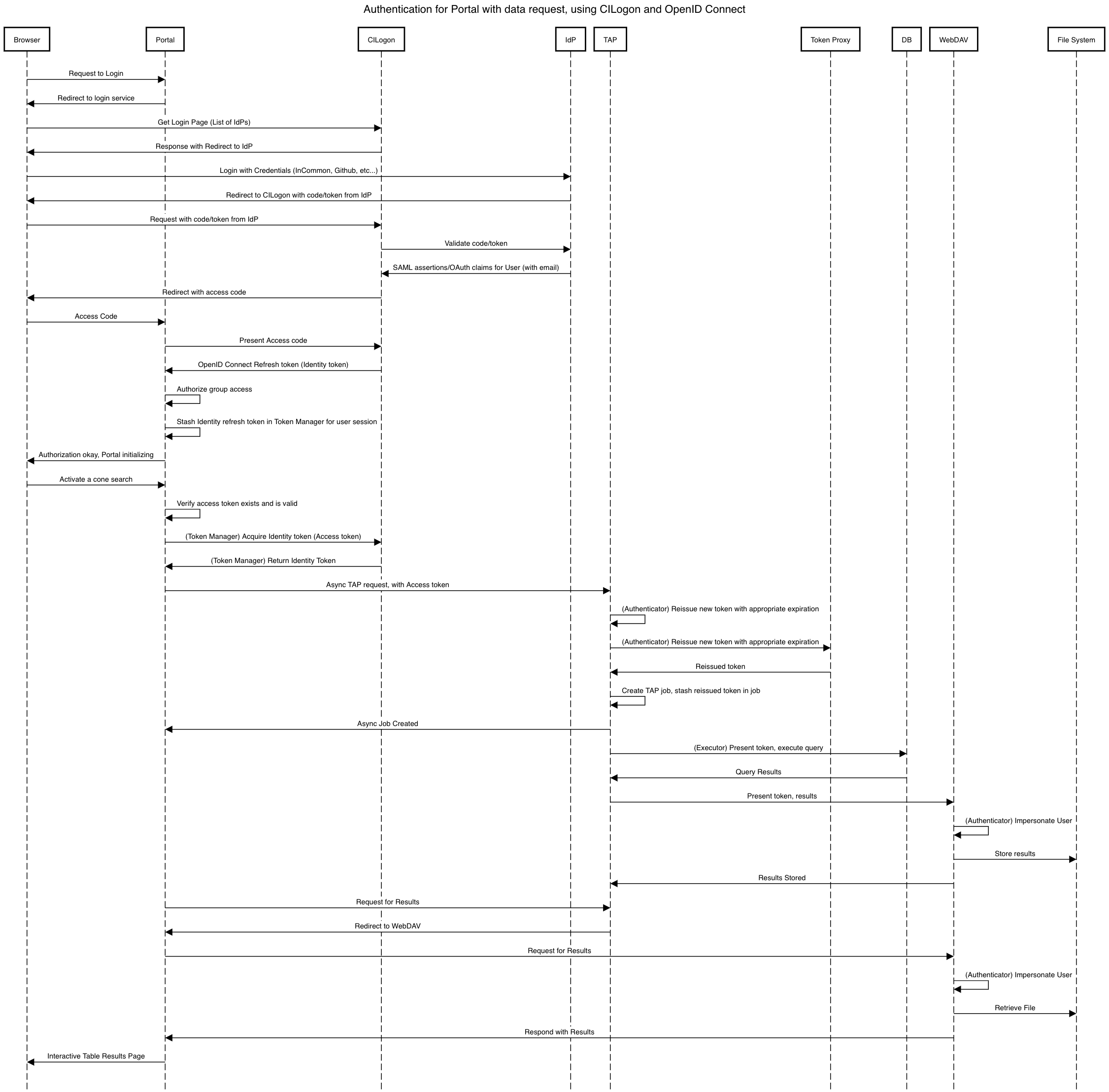
5.1.3 Application with Identity Tokens¶

5.2 Approach 2 - Capability Tokens¶
5.2.1 Notebook with Capability Token¶
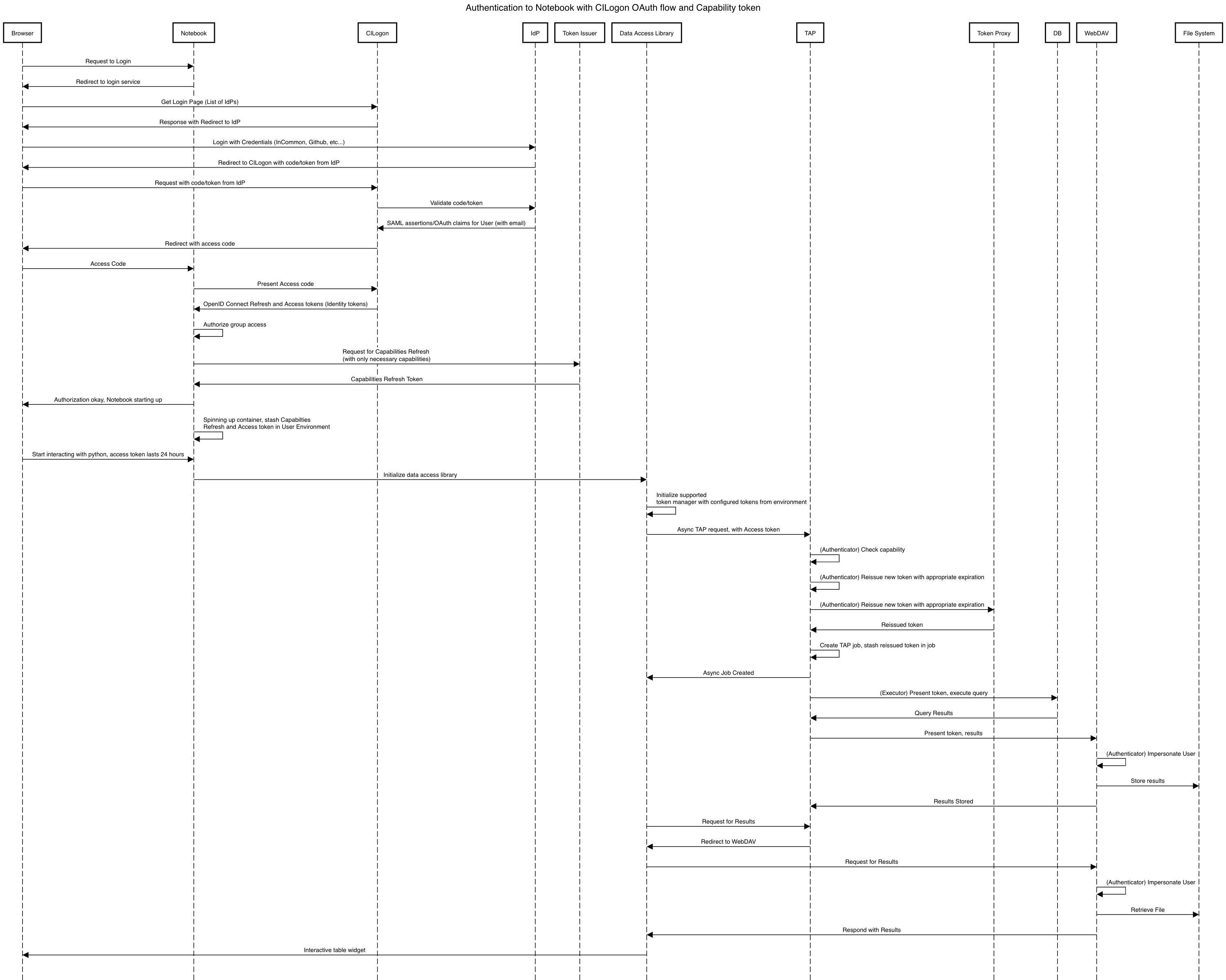
5.2.2 Portal with Capability Token¶
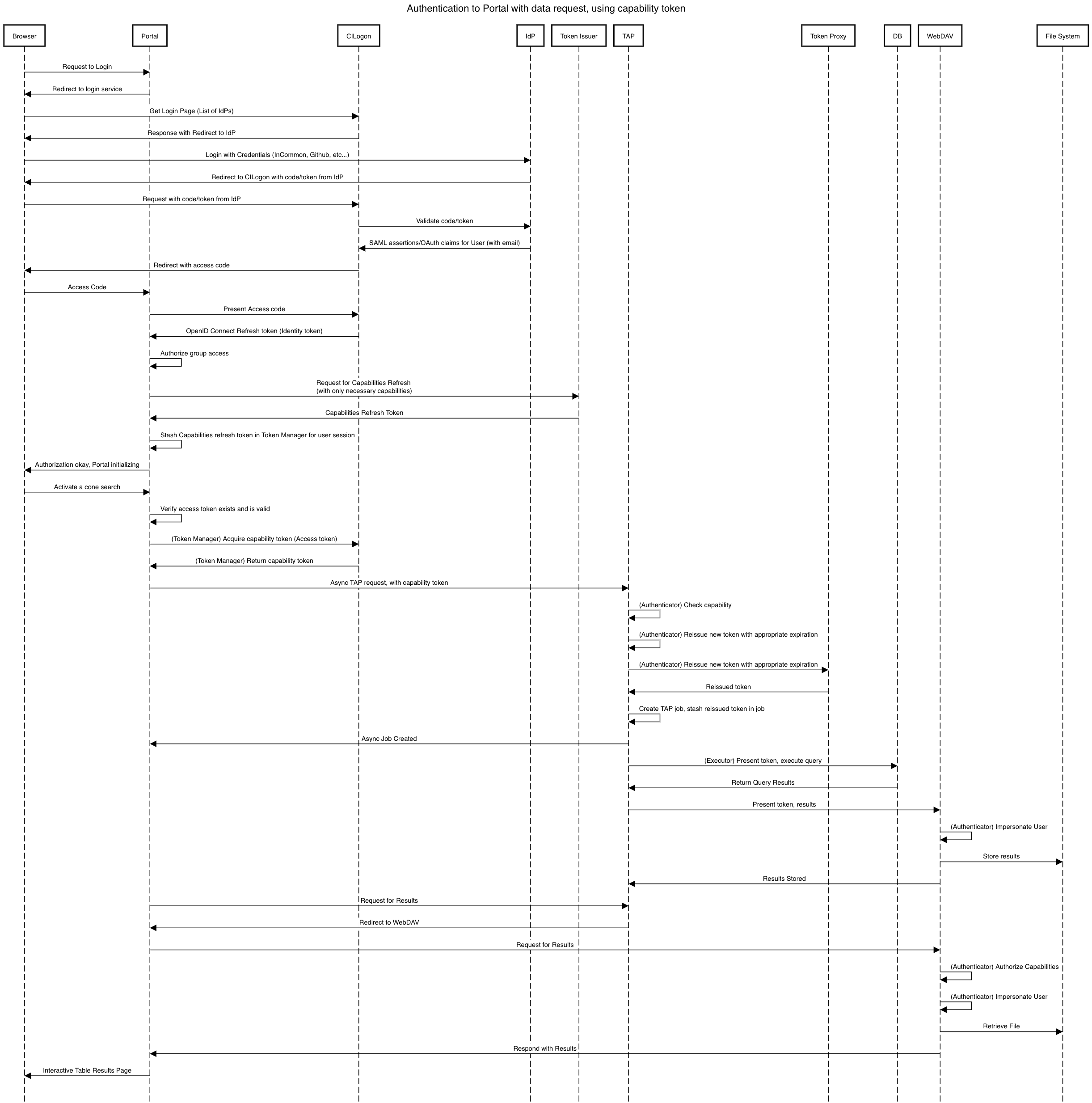
5.2.3 Application with Capability Token¶
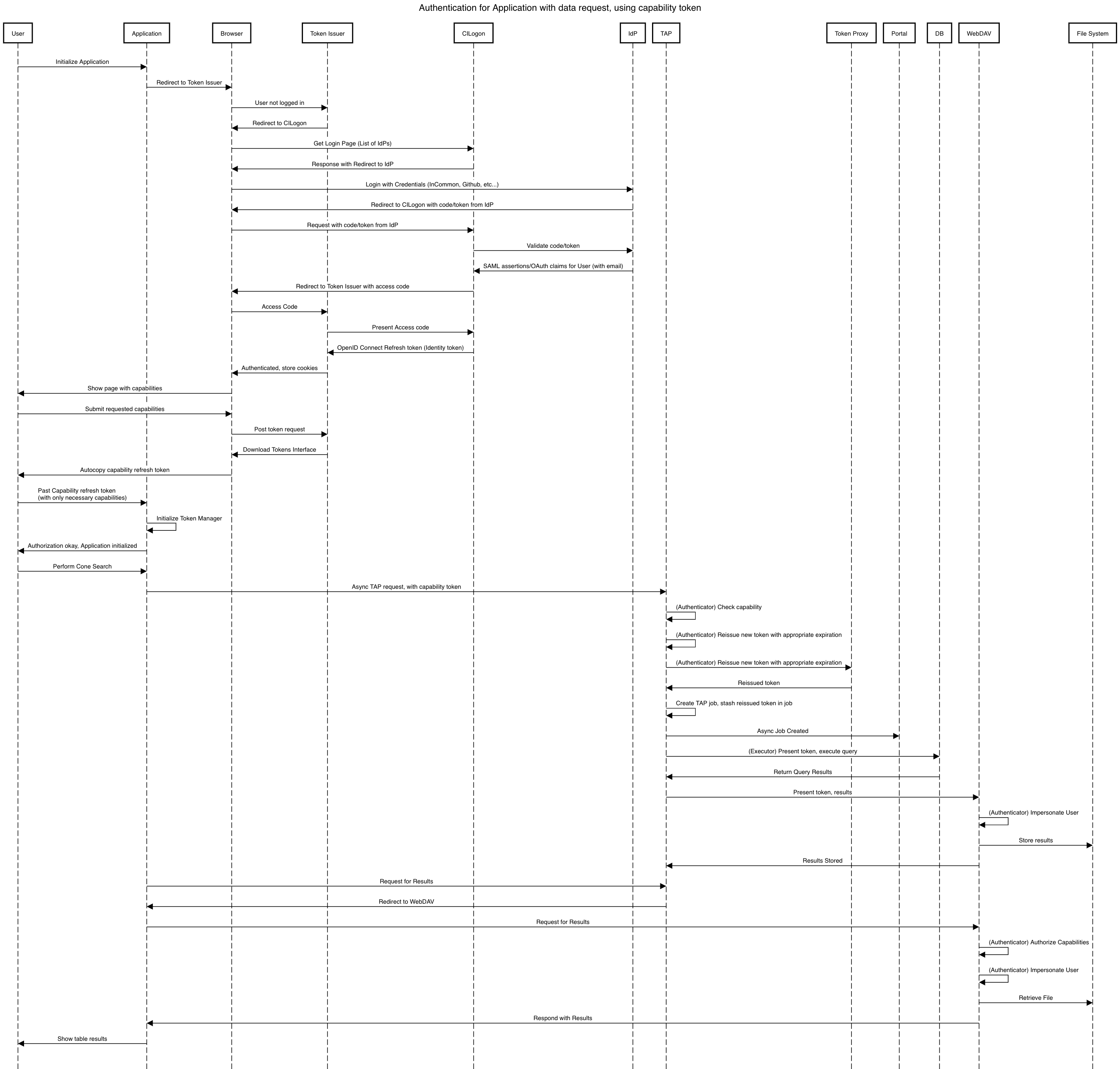
6 Appendix¶
InCommon and eduPerson to verify attributes about scientists, when possible;
CILogon to federate those identities and implement the return of identity data about users in the form of claims.
OAuth 2.0 as the generic protocol to interface with CILogon. OpenID Connect is layered over the OAuth 2.0 protocol to enable an authentication implementation.
OpenID Connect as the simple authentication layer on top of OAuth 2.0.
JWT as the implementation for identity tokens. This is also required as a result of using OpenID Connect.
6.1 InCommon Federation¶
InCommon is an identity federation in the United States that provides a common framework for identity management and trust across member institutions. The InCommon Federation’s identity management is built on top of eduPerson attributes. The interface used to interact with the federated institutions is Shibboleth.
6.2 OAuth 2.0¶
OAuth2 is a framework that enables users to authorize applications to retrieve information, either in the form of a token or through the use of a token, about the user from an identity provider. An identity provider may be Google, GitHub, or an institution. Typically, institutions themselves do not implement OAuth 2.0 interfaces, but they do implement interfaces with Shibboleth and SAML.
OAuth 2.0 specifies how you may ask for information about a user. It also specifies a method, through tokens, which a service may use to request and validate information about the user. OAuth 2.0 has several application flows that may be chosen based on the application at hand and desired security requirements.
6.2.1 Passing OAuth 2.0 Tokens¶
According to the OAuth 2.0 protocol, all tokens are transferred via the Authorization Header:
Authorization: Bearer [TOKEN]
This is the default, standard, and recommended way of passing ALL OAuth 2.0 tokens, whether it’s an OpenID Connect Identity token or a SciToken.
In some cases, existing clients of LSP services may exist that may not allow a user to send an arbitrary authorization header, or would need code to do so. Clients that support authorization can often be configured to provide an interface for HTTP Basic Authorization.
For compatibility with such systems, some services in the LSP, most importantly the WebDAV service,
MAY accept tokens in the Authorization header according to the HTTP Basic scheme, where the token is the
username and the password is x-oauth-basic or empty, or vice versa.
See also
https://github.blog/2012-09-21-easier-builds-and-deployments-using-git-over-https-and-oauth/
For clients which do not allow specifying a username and a password directly, additional compatibility may be possible by manually constructing the URL with the token in it:
https://<token>:x-oauth-basic@lsp.lsst.org/api
Warning
Care should be taken to always make the URL https, so tokens aren’t passed incorrectly.
6.3 OpenID Connect¶
OpenID Connect is a simple authentication layer on top of OAuth2. OpenID Connect specifies a small set of information about a user which may be used to authenticate a user using claims implemented according to the OAuth 2.0 specification.
6.4 CILogon¶
CILogon is a generic authentication proxy/clearing house for authentication providers from multiple services or institutions, especially institutions federated into the InCommon federation, as well as other services such as GitHub and Google. CILogon serves as a common endpoint for these various identity providers and translates their authentication mechanisms (OAuth 2.0, Shibboleth, OpenID Connect) to a common authentication mechanism while also translating claims when possible.
CILogon translates authentication information and user claims into OpenID Connect claims, layered on the OAuth 2.0 protocol. Using this, we typically know what institution a user is from, their email address, and whether or not they are faculty, staff, or a student. We may use this information to also map them to an NCSA user, provided that information has been previously captured, and potentially retrieve additional claims about that user, such as the groups they are a member of. Should we want additional claims beyond the subject of a token — claims such as group membership or capabilities — we will need to deploy a server to which we can present a refresh token that will provide us with those additional claims. We do not expect this implementation-specific server needs to be included in CILogon.
6.5 JWT¶
A JSON Web Token (JWT) is a way of representing claims as JSON, as well as information for validating those claims through the use of signatures (JWS) in the token, and a means of validating those signatures (JWE/JWK) — all in the same token. Included in the JWT specification is also a way of encoding a token using Base64 in a way that’s friendly for the web.
For all LSST applications, we use RSA256, an asymmetric algorithm, to sign the tokens.
We rely on tokens generated by CILogon to authenticate users in the browser. CILogon always returns an OpenID Connect JWT token.
A whitelist of token issuers we trust MUST be maintained, which includes CILogon and the token issuer for a given instance. Public keys used to validate tokens must be available from all token issuers, following the JWK specification. Applications should cache the JWK for a given token issuer for at least 5 minutes and not more than 1 hour.
All Access Tokens are based on JWT. Some access tokens may also include claims implemented according to the SciTokens specification.
See also
6.6 PKCE¶
Proof Key for Code Exchange (PKCE) is an extension to the
Authorization Code flow for OAuth 2.0. Primarily, it doesn’t require a secret OAuth 2.0
client_id, making it suitable for native applications, which are effectively public OAuth 2.0
clients.
6.7 SciTokens¶
SciTokens is an implementation of capabilities-based
authorizations built as specific claims inside a JWT token.
Those claims are modeled as lists of capabilities organized as colon-separated pairs of operations,
such as read, write, or execute, with arbitrary named resources. A named resource may be
a file path (e.g. read:/datasets/catalogs) or a more general resource (e.g.
read:mysql://server:3806/schema)
SciTokens recommends not using the subject (sub claim) for identity purposes. This implies that
SciTokens should not be used for authorizations based on identity.
SciTokens MUST be passed using one of the allowable methods defined for passing OAuth 2.0 Tokens.
A SciToken MUST come with a scope claim. The scope claim is a space-separated list of
capabilities. This is defined in RFC6749.
In accordance with the principle of least-privilege, a SciTokens issuer SHOULD also allow a user to attenuate or remove those capabilities with successive calls to the SciTokens issuer, trading an existing token for a more-attenuated one. This may be especially useful with Grid computing, for example. It’s important to consider the lifetime of a token in these scenarios to determine what token may be required.
6.8 Token lifetimes¶
Access token lifetimes are expected to be short, typically on the order of several hours or less, but may last as long as 24 hours, depending on the issuer and use case.
Refresh tokens, which are used to acquire access tokens in the OAuth 2.0 protocol, can last longer than those access tokens. It’s expected a refresh token will last at least 24 hours and may in some cases last a week or longer.
6.8.1 Token Acceptance Guarantee¶
The token proxy guarantees that the tokens that it issues to other Aspects will actually be usable when given to the API service. In order to guarantee this, the token proxy MUST issue a new token, with the same claims, during initial login. The lifetime of this token cannot exceed the lifetime of the refresh token received from CILogon, which is set at 24 hours.
Note
This implies the maximum length for an authenticated login session for the LSP, in the browser, is also set at 24 hours.
The token proxy also guarantees that the tokens will be usable for the duration of a serviced API request. To accomplish this, the token proxy MUST issue a new token for every serviced API request, with only the API aspect as the intended audience. The lifetime of this token is the upper bound for the limit of time it takes to service an API request, set at 24 hours.
The LSP API aspect services SHOULD NOT reissue new tokens reissued from previously serviced API requests.
Note
Safe HTTP methods, such as HEAD and GET requests SHOULD NOT need reissuance, as they SHOULD NOT take any other action other than simple retrieval.